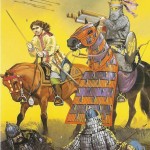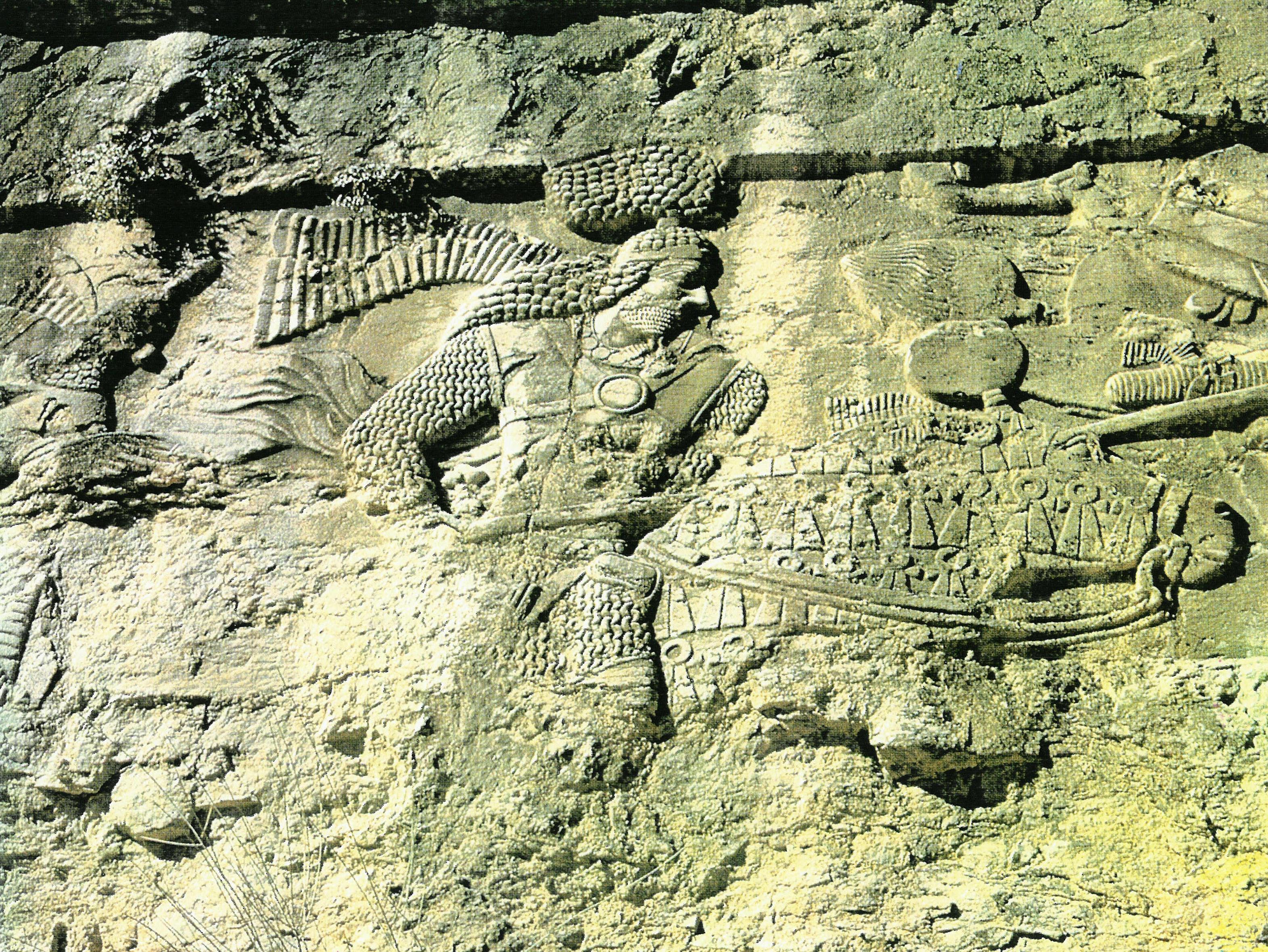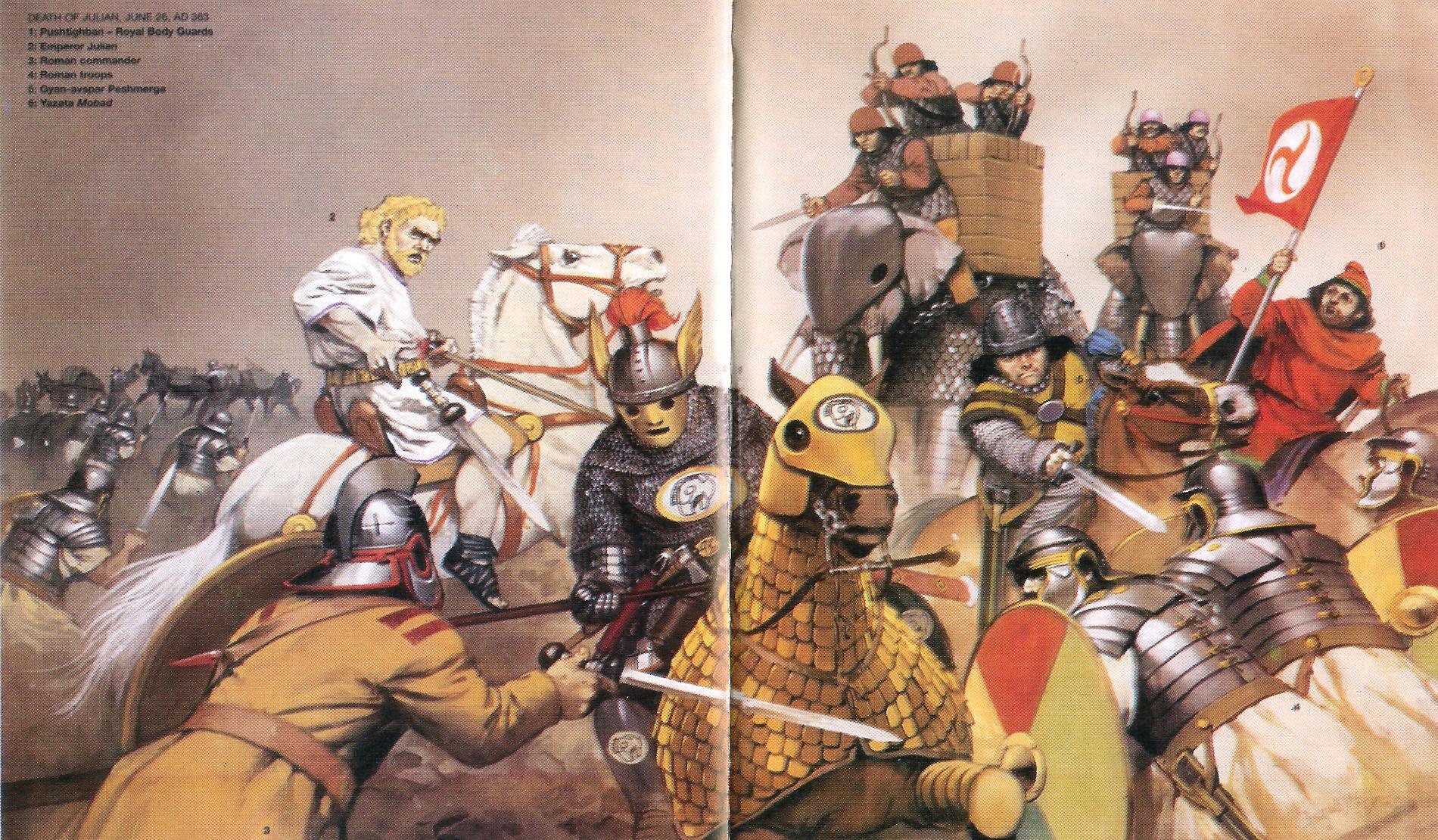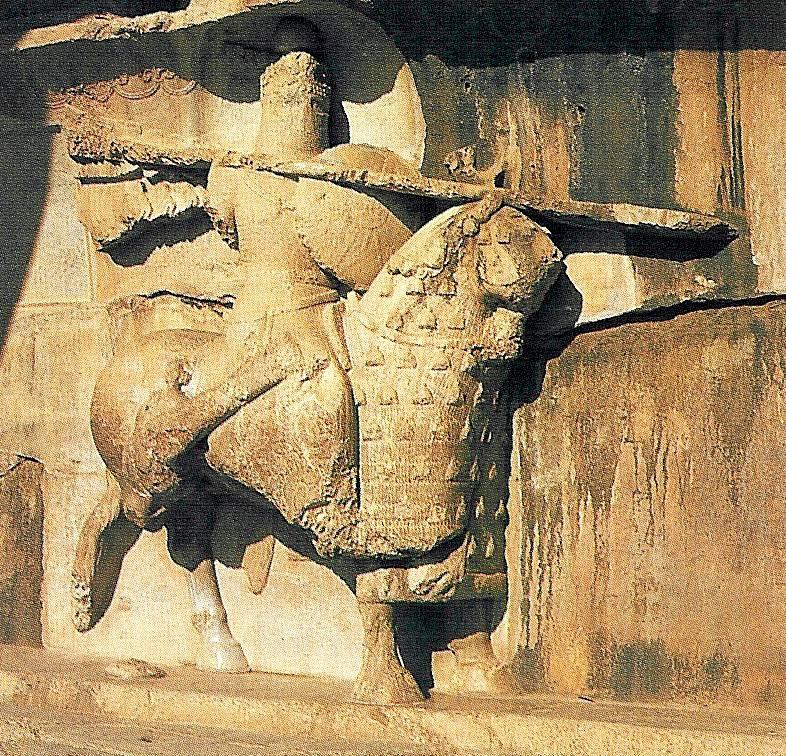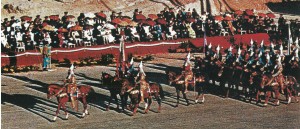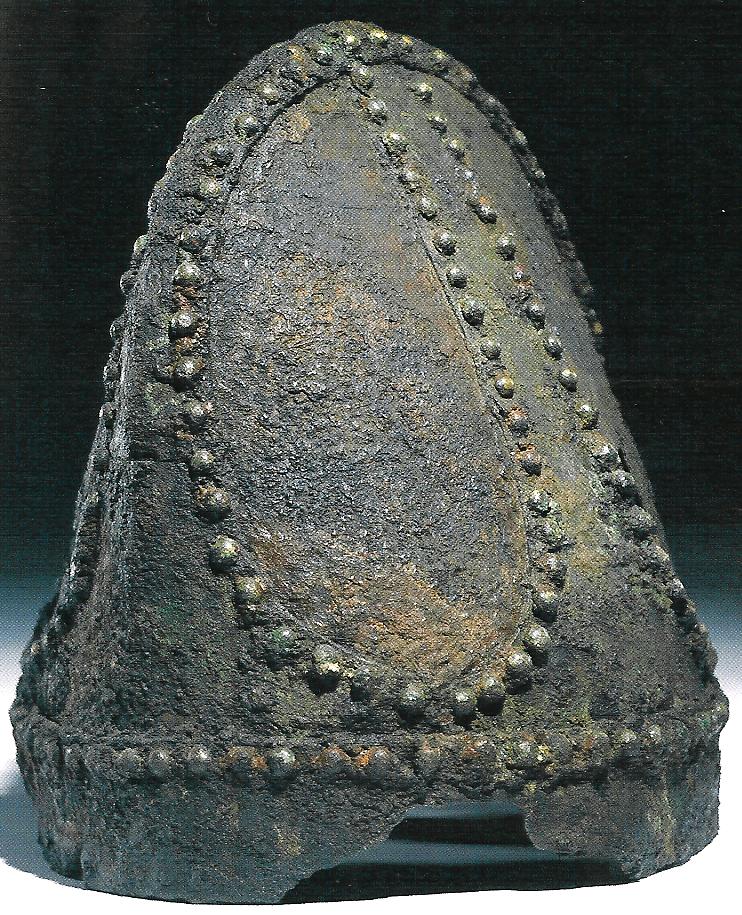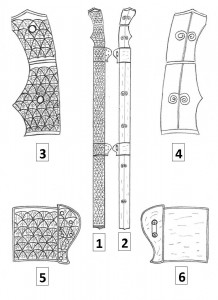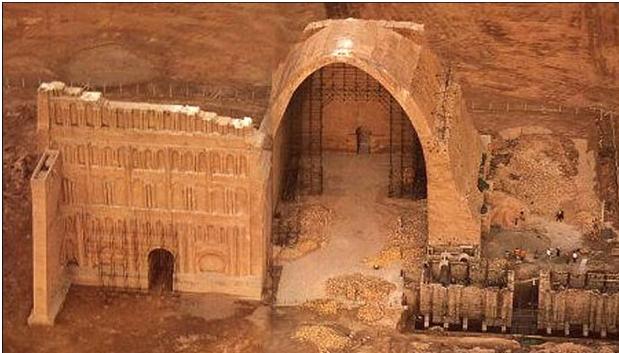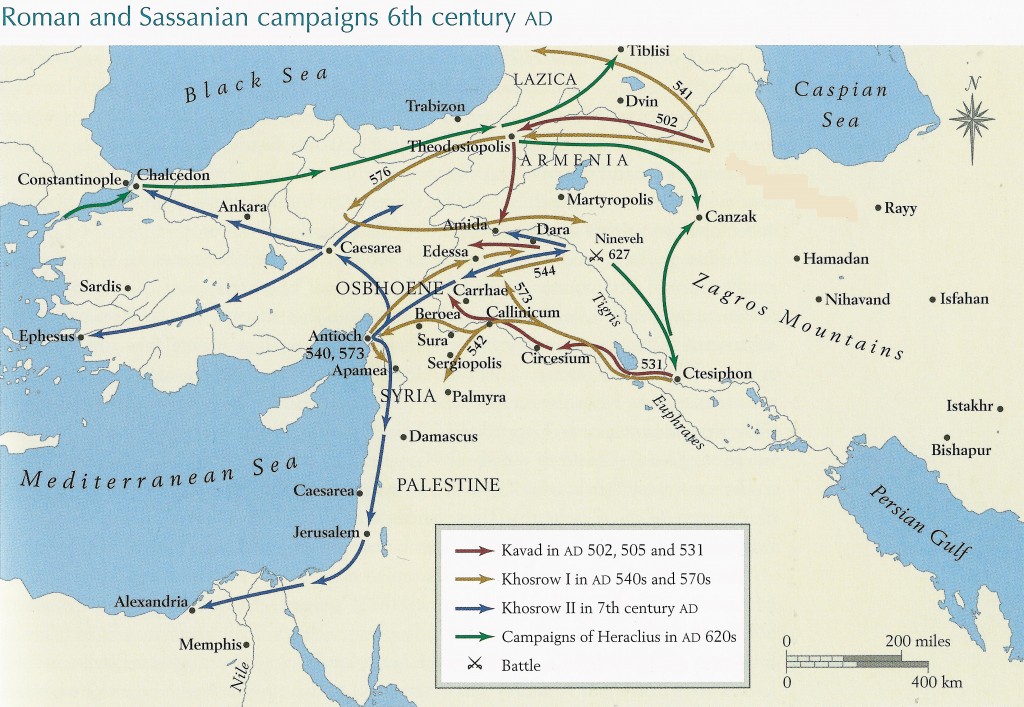The posting below highlights the late Professor Shapour Shahbazi’s discussion of the Sassanian army which was orginally published in the Encyclopedia Iranica on December 15, 1986 .
The notion of deriding the martial facets of Iran’s history can be partially traced to the political activities of the Iranian left and religious right mainly during the 1950s – 1970s, although the roots of Iranian anti-Iranism may be traced to earlier decades. There are presently links between Eurocentrists and similar minded Iranian anti-Iranists who share an antipathy towards Iranian military history and the legacy of Iranian history in general.
Trailer for the Arabian military history series “Omar”. The movie carefully avoids mention of the fact that Sassanian Persia and the Romano-Byzantine Empire had fought a devastating 22-year old war which resulted in the deaths of close to 400,000+ warriors on both sides (see Nabil Rastani: the Ancient World War and pages 256-261 in Shadows in the Desert: Ancient Persia at War-Персы: Армия великих царей-سایههای صحرا-). The Arabs attacked just 8-9 years after the Sassanian-Byzantine ceasefire in 628 CE, catching both empires when they were at the height of their military exhaustion. In short, the Arabs were not facing legions of first-rate and battle-experienced warriors when they invaded the Sassanian and Romano-Byzantine Empires. The movie also falsifies information by portraying the Elite Sassanian knights or Savaran (Arabic: Asawira) as cowardly when in fact Greco-Roman and even Arabo-Islamic historical sources contradict this. Perhaps the most important omission in the movie is the fact that numbers of Iranians actually joined the invading forces to fight against the Sassanian Empire. On the other hand, the movie correctly portrays the military equipment of the Arabs at the time; the Arabs for example carried straight swords rather than the later curved sabres of Turkish origin.
The latest research by Dr. Parvaneh Pourshariati indicates that the fundamental reason for the fall of the Sassanians was due to the process of political disintegration between the Arsacids (Parthian) clans and the Sasanian royal family. For more on this topic see:
Parvaneh Pourshariati (2008). Decline and Fall of the Sasanian Empire: The Sasanian-Parthian Confederacy and the Arab Conquest of Iran (International Library of Irani. I. B. Tauris. See Foreword (translated to Persian) by Khashayar Rokhasani –پیشگفتار: خشایار رُخسانی –; See first chapter (translated to Persian) –نشیب و فروپاشی فرمانروایی ساسانی– (pdf).
For more on Sassanian Military History click on the picture below:
Kindly note that a number of pictures displayed in the Shahbazi article below are from Kaveh Farrokh’s lectures at the University of British Columbia’s Continuing Studies Division , Stanford University’s WAIS 2006 Critical World Problems Conference Presentations on July 30-31, 2006; as well as various textbooks such as Ian Hughes’ textbook –Belisarius-the Last Roman General and Farrokh’s texts اسواران ساسانی– Elite Sassanian cavalry, 2005 and Shadows in the Desert: Ancient Persia at War-Персы: Армия великих царей-سایههای صحرا-.
==========================================================================
The Iranian society under the Sasanians was divided—allegedly by Ardašīr I—into four groups: priests, warriors (artēštār), state officials, and artisans and peasants. The second category embraced princes, lords, and landed aristocracy (Christensen, Iran Sass., p. 98), and one of the three great fires of the empire, Ādur Gušnasp at Šīz (Taḵt-e Solaymān in Azerbaijan) belonged to them (ibid., pp. 166f.). With a clear military plan aimed at the revival of the Persian empire (Dio Cassius 80.4.2; Herodian 6.2.2), Ardašīr I formed a standing army which was under his personal command and its officers were separate from satraps and local princes and nobility (Agathangelos
[Click to Enlarge] Ardashir I in a lance-joust scene at Firuzabad which ciommemorates the great battle in which the House of Sassan overthrew the Parthians in 224 CE. Note the large hair bundle (Korymbos) on top of Ardashir I’s head (Picture source: Photo taken by Farrokh in August 2001 and shown in Kaveh Farrokh’s lectures at The University of British Columbia’s Continuing Studies Division , Stanford University’s WAIS 2006 Critical World Problems Conference Presentations on July 30-31, 2006).
The backbone of the spāh was its heavy cavalry “in which all the nobles and men of rank” underwent “hard service” (Ammianus Marcellinus 23.6.83) and became professional soldiers “through military training and discipline, through constant exercise in warfare and military manoeuvers” (ibid.). From the third century the Romans also formed units of heavy cavalry of the Oriental type (Rundgren, Orientalia Suecana 6, 1957, pp. 35ff.); they called such horsemen clibanarii “mail-clad [riders]” (e.g. Ammianus Marcellinus 16.10.8), a term thought to have derived from an Iranian *grīwbānar < *grīwbānwar < *grīva-pāna-bara “neck-guard wearer” (Rundgren, op. cit., pp. 48f., evidently unaware that the Pahlavi grīwbān “neck-guard” is attested inVendidad 14.9: A.V. W. Jackson, “Herodotus VII. 61, or the Arms of the Ancient Persians Illustrated from Iranian Sources,” in Classical Studies in Honour of Henry Drisler, New York, 1894, pp. 95ff., esp. p. 118). The heavy cavalry of Šāpūr II is described by an eye-witness historian as follows: “all the companies were clad in iron, and all parts of their bodies were covered with thick plates, so fitted that the stiff joints conformed with those of their limbs; and the forms of human faces were so skillfully fitted to their heads, that since their entire body was covered with metal, arrows that fell upon them could lodge only where they could see a little through tiny openings opposite the pupil of the eye, or where through the tip of their nose they were able to get a little breath. Of these some who were armed with pikes, stood so motionless that you would have thought them held fast by clamps of bronze” (Ammianus Marcellinus 25.1. 12-13, cf. 24.6.8).
[CLICK TO ENLARGE]- Emperor Julian is killed during his failed invasion of Sassanian Persia in June 26, 363 AD. Above is a recreation of Sassanian Persia’s elite cavalry, the Savaran, as they would have appeared during Julian’s failed invasion. Note the heavily armored Sassanian elite guardsman (Pushtighban) whose lance has pierced a Roman infantryman. Further right is a Savaran officer whose sword is drawn in what is now known as the “Italian grip” but Sassanian in origin. To the far right can be seen a Zoroastrian or Mithraist Magus brandishing a Sassanian era symbol. Also of interest are the armored elephants in the background. Armored elephants were especially prized as their cabs afforded very high elevation over the battlefield, which was ideal for Sassanian archery ( Picture source: Farrokh, Plate D, -اسواران ساسانی- Elite Sassanian cavalry, 2005).
AThe described horsemen are represented by the seventh-century knight depicting Ḵosrow Parvēz on his steed Šabdīz on a rock relief at Ṭāq-e Bostān in Kermānšāh (E. Herzfeld, AMI 9/1938, pp. 91ff.). Since the Sasanian horseman lacked the stirrup (A. D. H. Bivar, “The Stirrup and its origins,” Oriental Art, N.S. 1, 1965, pp. 61-65), he used a war saddle which, like the medieval type, had a cantle at the back and two guard clamps curving across the top of the rider’s thighs enabling him thereby to stay in the saddle especially during violent contact in battle (E. F. Schmidt, Persepolis III, Chicago, 1970, p. 135). The inventory of weapons ascribed to Sasanian horsemen at the time of Ḵosrow Anōšīravān (Ṭabarī, I, p. 964 [tr. Nöldeke, pp. 248f.]; Baḷʿami, Tārīḵ, p. 1048; Ferdowsī, Šāh-nāma VIII, p. 63), resembles the twelve items of war mentioned in Vendidad 14.9 (Jackson, loc. cit.), thus showing that this part of the text had been revised in the later Sasanian period.
[Click to Enlarge] An excellent depiction of late sassanian knights at Taghe Bostan. The figure is oftne identified as Khosrow II “Parviz” and his steed, Sabdiz (Picture source: Farrokh, page 225, Shadows in the Desert: Ancient Persia at War-Персы: Армия великих царей-سایههای صحرا–).
More interestingly, the most important Byzantine treatise on the art of war, the Strategicon, also written at this period, requires the same equipments from a heavily-armed horseman (Bivar in Dumbarton Oaks Papers 26, 1972, pp. 287-88). This was due to the gradual orientalization of the Roman army to the extent that in the sixth century “the military usages of the Romans and the Persians become more and more assimilated, so that the armies of Justinian and Khosrow are already very much like each other;” and, indeed, the military literatures of the two sides show strong affinities and interrelations (C. A. Inostrantsev, “Sasanian Military Theory,” tr. L. Bogdanov in Journal of the Cama Oriental Institute 7, 1926, pp. 7ff. esp. p. 23). According to the Iranian sources mentioned above, the martial equipments of a heavily-armed Sasanian horseman were as follows: helmet, hauberk (Pahlavi grīwbān), breastplate, mail, gauntlet (Pahlavi abdast), girdle, thigh-guards (Pahlavi rān-ban), lance, sword, battle-axe, mace, bowcase with two bows and two bowstrings, quiver with 30 arrows, two extra bowstrings, spear, and horse armor (zēn-abzār); to these some have added a lasso (kamand), or a sling with slingstones (Nöldeke, Geschichte der Perser, pp. 248f.; Jackson, op. cit., pp. 108ff.). The elite corps of the cavalry was called “the Immortals,” evidently numbering—like their Achaemenid namesakes—10,000 men (Christensen, Iran Sass., p. 208 with references). On one occasion (under Bahrām V) the force attacked a Roman army but outnumbered, it stood firm and was cut down to a man (Socrates Scholasticus 7.20). Another elite cavalry group was the Armenian one, whom the Persians accorded particular honor (Christensen, op. cit., p. 210). In due course the importance of the heavy cavalry increased and the distinguished horseman assumed the meaning of “knight” as in European chivalry; if not of royal blood, he ranked next to the members of the ruling families and was among the king’s boon companions (ibid., pp. 112, 368-69; J. M. Unvala, The Pahlavi Text “King Ḫusrav and his Boy,” Paris, 1921).
Recreation of the Savaran during the 2,500 year celebrations in Iran, 1971 (Picture source: Farrokh, page 222, Shadows in the Desert: Ancient Persia at War-Персы: Армия великих царей-سایههای صحرا–).
The Sasanians did not form light-armed cavalry but extensively employed—as allies or mercenaries—troops from warlike tribes who fought under their own chiefs. “The Sagestani were the bravest of all” (Ammianus Marcellinus 19.2.3); the Gelani, Albani and the Hephthalites, the Kushans and the Khazars were the main suppliers of light-armed cavalry. The skill of the Dailamites in the use of sword and dagger made them valuable troopers in close combat (Agathias 3.17), while Arabs were efficient in desert warfare (Christensen, op. cit., pp. 209, 275).
The infantry (paygān) consisted of the archers and ordinary footmen. The former were protected “by an oblong curved shield, covered with wickerwork and rawhide” (Ammianus Marcellinus 24.6.8). Advancing in close order, they showered the enemy with storms of arrows. The ordinary footmen were recruited from peasants and received no pay (ibid., 23.6.83), serving mainly as pages to the mounted warriors; they also attacked walls, excavated mines and looked after the baggage train, their weapons being a spear and a shield (ibid., 23.6.83; Procopius 1.14.24, 52; Christensen, op. cit., p. 209). The cavalry was better supported by war elephants “looking like walking towers” (Ammianus Marcellinus 25.1.14; sec also E. Herzfeld AMI 3, 1931, pp. 26ff.), which could cause disorder and damage in enemy ranks in open and level fields. War chariots were not used by the Sasanians (contra Alexander Severus in Lampridius, Vita Alex. Sev. 56). Unlike the Parthians, however, the Persians organized an efficient siege machine for reducing enemy forts and walled towns. They learned this system of defense from the Romans but soon came to match them not only in the use of offensive siege engines—such as scorpions, balistae, battering rams, and moving towers—but also in the methods of defending their own fortifications against such devices by catapults, by throwing stones or pouring boiling liquid on the attackers or hurling fire brands and blazing missiles (Ammianus Marcellinus 19.5f., 20.6-7, 11).
Sassanian helmet of riveted construction of the “Spangenhelm” type, discovered at Ninenveh, dated to 5th – 7th centuries CE (Picture source: Farrokh, page 222, Shadows in the Desert: Ancient Persia at War-Персы: Армия великих царей-سایههای صحرا-).
The organization of the Sasanian army is not quite clear, and it is not even certain that a decimal scale prevailed, although such titles as hazārmard (Nöldeke, Geschichte der Perser, p. 284 n. 2) might indicate such a system. Yet the proverbial strength of an army was 12,000 men (Ferdowsī, Šāh-nāma VIII, p. 343). The total strength of the registered warriors in 578 was 70,000 (Ṭabarī, tr. Nöldeke, p. 271). The army was divided, as in the Parthian times, into several gunds, each consisting of a number of drafšs (units with particular banners), each made up of some wašts (Christensen, op. cit., p. 210). The imperial banner was the Drafš-e Kāvīān, a talismanic emblem accompanying the Great King or the commander-in-chief of the army who was stationed in the center of his forces and managed the affairs of the combat from the elevation of a throne (A. Christensen, Smeden Kāväh, tr. Unvala, pp. 28f.). At least from the time of Ḵosrow Anōšīravān a seven-grade hierarchical system seems to have been favored in the organization of the army (M. Grignaschi, “Quelques spécimens de la litterature sassanide conservés dans les bibliothèques d’Istanbul,” JA, 1966, pp. 1ff. esp. pp. 24, 42 n. 76).
The highest military title was argbed (q.v.) which was a prerogative of the Sasanian family (Nöldeke, op. cit., p. 5 n. 3). Until Ḵosrow Anōšīravān’s military reforms, the whole of the Persian army was under a supreme commander, Ērān-spāhbed, who acted as the minister of defense, empowered to conduct peace negotiations; he usually came from one of the great noble families and was counted as a counselor of the Great King (Christensen, Iran Sass., pp. 130f.). Along with the revival of “heroic” names in the middle of the Sasanian period, an anachronistic title, artēštārān sālār (q.v., Greek rendering adrastadaran salanes: Procopius 1.6. 18) was coined to designate a generalissimo with extraordinary authority, but this was soon abandoned when Anōšīravān abolished the office of Ērān-spāhbed and replaced it with those of the four marshals (spāhbed) of the empire, each of whom was the military authority in one quarter of the realm (Christensen, op. cit., pp. 131, 370). Other senior officials connected with the army were: Ērān-ambāragbed “minister of the magazines of empire,” responsible for the arms and armaments of warriors (ibid., pp. 107-108); the marzbāns “margraves”—rulers of important border provinces (ibid., pp. 102, 108, 371ff.; 518ff.); kanārang—evidently a hereditary title of the ruler of Ṭūs (ibid., pp. 108, 351, 507); gund-sālār “general” (ibid., p. 210); paygān-sālār “commander of the infantry” (ibid.); and puštigbān-sālār “commander of the royal guard” (ibid.).
Late Sassanian sword from Dailaman, northern Iran (Picture source: Farrokh, page 222, Shadows in the Desert: Ancient Persia at War-Персы: Армия великих царей-سایههای صحرا-).
A good deal of what is known of the Sasanian army dates from the sixth and seventh centuries when, as the results of Anōšīravān’s reforms, four main corps were established; soldiers were enrolled as state officials receiving pay and subsidies as well as arms and horses; and many vulnerable border areas were garrisoned by resettled warlike tribes (ibid., pp. 367ff.). The sources are particularly rich in accounts of the Sasanian art of warfare because there existed a substantial military literature, traces of which are found in the Šāh-nāma, Dēnkard 8.26—an abstract of a chapter of the Sasanian Avesta entitled Artēštārestān “warrior code”—and in the extracts from the Āʾīn-nāma which Ebn Qotayba has preserved in his ʿOyūn al-aḵbār and Inostrantsev has explained in detail (in Journal of the Cama Oriental Institute 7, 1926, pp. 7-52; see also Christensen, op. cit., pp. 215f.).
Late Sassanian sword (Farrokh 2004; reprinted Hughes 2010, p.51). Entire sword from front [1] and back [2]; sword handle at front [3] and back [4]; sword mount at front [5] and back [6].
The Artēštārestān was a complete manual for the military: it described in detail the regulations on recruitments, arms and armor, horses and their equipments, trainings, ranks, and pay of the soldiers and provisions for them, gathering military intelligence and taking precaution against surprise attack, qualifications of commanders and their duties in arraying the lines, preserving the lives of their men, safeguarding Iran, rewarding the brave and treating the vanquished (Sanjana’s tr. in Dēnkard, vol. XVI, Bombay, 1917, pp. 6ff.). The Āʾīn-nāma furnished valuable instructions on tactics, strategy and logistics. It enjoined, for instance, that the cavalry should be placed in front, left-handed archers capable of shooting to both sides be positioned on the left wing, which was to remain defensive and be used as support in case of enemy advance, the center be stationed in an elevated place so that its two main parts (i.e., the chief line of cavalry, and the lesser line of infantry behind them) could resist enemy charges more efficiently, and that the men should be so lined up as to have the sun and wind to their back (Inostrantsev, op. cit., pp. 13ff.).
Battles were usually decided by the shock cavalry of the front line charging the opposite ranks with heavy lances while archers gave support by discharging storms of arrows. The center, where the commander-in-chief took his position on a throne under the Drafš-e Kāvīān, was defended by the strongest units. Since the carrying of the shield on the left made a soldier inefficient in using his weapons leftwards, the right was considered the line of attack, each side trying to outflank the enemy from that direction, i.e., at the respective opponent’s left; hence, the left wing was made stronger but assigned a defensive role (ibid., pp. 16ff.; Bivar, op. cit., pp. 289f.). The chief weakness of the Persian army was its lack of endurance in close combat (Ammianus Marcellinus 25.1.18). Another fault was the Persian’s too great a reliance on the presence of their leader: the moment the commander fell or fled his men gave way regardless of the course of action.
[Click to Enlarge] Iranian belt from the Sassanian era found in the Caucasus (Picture source: Farrokh, page 214, Shadows in the Desert: Ancient Persia at War-Персы: Армия великих царей-سایههای صحرا-Picture printed in text was under the Courtesy of the Institute of Manuscripts, Georgian Academy of Sciences and printed specifically with the permission of Dr. David Khoupenia) .
During the Sasanian period the ancient tradition of single combat (mard o-mard) developed to a firm code (Christensen, op. cit., p. 216). In 421 Bahrām V opposed a Roman army but accepted the war as lost when his champion in a single contest was slain by a Goth from the Roman side (Johannes Malalas [in B. G. Niebuhr, ed., Hist. Byzant. Scriptores, Bonn, 1831], p. 14a). Such duels are represented on several Sasanian rock-reliefs at Naqš-e Rostam (Schmidt, Persepolis III, pp. 130ff.), and on a famous cameo in Paris depicting Šāpūr I capturing Valerian (R. Ghirshman, Iran 249 B.C.-A.D. 657: The Parthian and Sassanian Dynasties, London, 1962, fig. 195).
Sasanian kings were conscious of their role as military leaders: many took part in battle, and some were killed; the Picture Book of Sasanian Kings showed them as warriors with lance or sword (Ḥamza, pp. 50-54; Moǰmal, pp. 33ff.). Some are credited with writing manuals on archery (Bivar, op. cit., p. 284), and they are known to have kept accounts of their campaigns (e.g., Šāpūr’s inscription on the Kaʿba-ye Zardošt, and cf. Ebrāhīm b. Moḥammad Bayhaqī, al-Moḥāsen wa’l-mosāwī, ed. F. Schwally, Giessen, 1902, p. 481: “When Ḵosrow Parvēz concluded his wars with Bahrām-e Čūbīna and consolidated his rule over the empire, he ordered his secretary to write down an account of those wars and related events in full, from the beginning to the end”).
Remains of the Archway of Ctesiphon, capital of the Sasanian Empire (224-651 AD). Picture and caption from Kaveh Farrokh’’s lectures at the University of British Columbia’s Continuing Studies Division and were also presented at Stanford University’s WAIS 2006 Critical World Problems Conference Presentations on July 30-31, 2006).
While heavy cavalry proved efficient against Roman armies, it was too slow and regimentalized to act with full force against agile and unpredictable light-armed cavalry and rapid foot archers; the Persians who in the early seventh century conquered Egypt and Asia Minor lost decisive battles a generation later when nimble, lightly armed Arabs accustomed to skirmishes and desert warfare attacked them. Hired light-armed Arab or East Iranian mercenaries could have served them much better.
[Click to Enlarge] Map of the Sassanian and Roman campaigns of the 6th century CE (Picture source: Farrokh, page 233, Shadows in the Desert: Ancient Persia at War-Персы: Армия великих царей-سایههای صحرا-). The end result of the ensuing long and devastating Romano-Sassanian wars of the early 7th century CE was the creation of a military vacuum which was to be adeptly expolited by the Arabo-Islamic invasion forces of the newly established Caliphate in Arabia.
